 Who: Penelope Spheeris is a Los Angeles-based filmmaker whose career as a documentarian goes back to the 1970’s, when she worked as a film editor and cinematographer, forming LA’s first music video production company in 1974 — Rock ‘N Reel. In addition to producing, directing, and editing videos for various major bands, Spheeris spent the period between December of 1979 and May of 1980 filming punk rock bands like Black Flag, The Germs, X and Fear at several small Los Angeles-area clubs. She also filmed intimate interviews with the bands, some young concertgoers, and the staff of punk rock fanzine, Slash, before putting all of it together as The Decline of Western Civilization. Spheeris stayed with the subject of LA punk rock for her first narrative film, when she wrote and directed 1983’s Suburbia, about transient youths squatting together in abandoned local houses. Spheeris filmed two more Decline films within the Los Angeles music scene, exploring both ’80’s “hair metal” excess and ’90’s “gutter punk” desperation. Spheeris directed her first studio film, 1992’s Wayne’s World, during a period where she expanded her music documentation into the Rap genre with 1990’s Banned in the USA and 1991’s Lifer’s Group. Spheeris chronicled the Ozzfest tour in 1999, featuring Ozzy Osbourne, for 2001’s We Sold Our Souls For Rock ‘N Roll, but the film has never had a wide release due to unresolved music rights issues. Spheeris is currently negotiating a U.S. and Canadian theatrical release for her latest feature film, Balls to the Wall, while also working on a comprehensive DVD release of all three Decline films. Her new short film, Cheyenne will soon be aired as part of Lifetime network’s Project Five anthology program, depicting the lives of different breast cancer sufferers.
Who: Penelope Spheeris is a Los Angeles-based filmmaker whose career as a documentarian goes back to the 1970’s, when she worked as a film editor and cinematographer, forming LA’s first music video production company in 1974 — Rock ‘N Reel. In addition to producing, directing, and editing videos for various major bands, Spheeris spent the period between December of 1979 and May of 1980 filming punk rock bands like Black Flag, The Germs, X and Fear at several small Los Angeles-area clubs. She also filmed intimate interviews with the bands, some young concertgoers, and the staff of punk rock fanzine, Slash, before putting all of it together as The Decline of Western Civilization. Spheeris stayed with the subject of LA punk rock for her first narrative film, when she wrote and directed 1983’s Suburbia, about transient youths squatting together in abandoned local houses. Spheeris filmed two more Decline films within the Los Angeles music scene, exploring both ’80’s “hair metal” excess and ’90’s “gutter punk” desperation. Spheeris directed her first studio film, 1992’s Wayne’s World, during a period where she expanded her music documentation into the Rap genre with 1990’s Banned in the USA and 1991’s Lifer’s Group. Spheeris chronicled the Ozzfest tour in 1999, featuring Ozzy Osbourne, for 2001’s We Sold Our Souls For Rock ‘N Roll, but the film has never had a wide release due to unresolved music rights issues. Spheeris is currently negotiating a U.S. and Canadian theatrical release for her latest feature film, Balls to the Wall, while also working on a comprehensive DVD release of all three Decline films. Her new short film, Cheyenne will soon be aired as part of Lifetime network’s Project Five anthology program, depicting the lives of different breast cancer sufferers.
What are the roots of your music documentary work in Los Angeles?
 Having a very, very difficult upbringing, and living in trailers, and having seven stepfathers and moving around all the time — I kind of turned to rock ‘n roll as a little comfort blanket, and it made me feel better to listen to music. And then, when I heard there was a film school at UCLA, I was studying the biological sciences at University of Irvine out in Orange County. I went, “Oh my God, there’s a place where you can go and learn how to make movies? That’s just crazy.” I mean, I hadn’t ever heard of it before. So I went to UCLA film school, and right when I graduated, a friend of mine that I had met at a concert, Peter Philbin, called me up. He worked at CBS Records, and he goes, “Would you like to do a music video?” And I said, “Well, what is that?” And we’re talking 1974, something like that, and he said, “Well, we just figured out we don’t have to send these crazy bands all over the world, and have them throw mattresses out of the hotel rooms. We can just send a piece of film.” So I started a company called Rock ‘n Reel, and I shot a lot of music videos, and I did a huge amount of sales presentations over at Warner Brothers Records. So I had a thorough and complete music love and background and experience in filmmaking before I did the first Decline, because I was such a music fan, and I was actually working in the business shooting music videos. And I often had to shoot bands I wasn’t into.
Having a very, very difficult upbringing, and living in trailers, and having seven stepfathers and moving around all the time — I kind of turned to rock ‘n roll as a little comfort blanket, and it made me feel better to listen to music. And then, when I heard there was a film school at UCLA, I was studying the biological sciences at University of Irvine out in Orange County. I went, “Oh my God, there’s a place where you can go and learn how to make movies? That’s just crazy.” I mean, I hadn’t ever heard of it before. So I went to UCLA film school, and right when I graduated, a friend of mine that I had met at a concert, Peter Philbin, called me up. He worked at CBS Records, and he goes, “Would you like to do a music video?” And I said, “Well, what is that?” And we’re talking 1974, something like that, and he said, “Well, we just figured out we don’t have to send these crazy bands all over the world, and have them throw mattresses out of the hotel rooms. We can just send a piece of film.” So I started a company called Rock ‘n Reel, and I shot a lot of music videos, and I did a huge amount of sales presentations over at Warner Brothers Records. So I had a thorough and complete music love and background and experience in filmmaking before I did the first Decline, because I was such a music fan, and I was actually working in the business shooting music videos. And I often had to shoot bands I wasn’t into.
I was into The Screamers and The Weirdos and The Gears. I mean, when I was at Irvine, I saw Janis Joplin play. I remember standing by the stage looking at her feet going, “This bitch is barefoot.” And I went to see Blue Cheer down on the pier over in Santa Monica at this club called the Cheetah. We would stand in line out there on the beach trying to get up onto the pier. This friend of mine named Sepp Donahower promoted, I think it was called Pinnacle, and there’s some very famous posters that John Van Hamersveld did of the Pinnacle shows. This was all going on at the same time as this hippie shit in San Francisco was happening. And I went over to the Shrine Auditorium and saw the Mothers of Invention. One night, this guitar player came on and had his back to the audience, and I was standing like 10 feet away from him, spinning on acid or something. And I’m looking, and everyone’s going, “Who the hell is this guy?” And Zappa’s up there, and all the Mothers are up there. Then he turned around, and it’s Eric Clapton. So you know, I was between the Cheetah and the Shrine and the Santa Monica Civic, all those shows. And I was always at the Troubadour, because my friend who hooked me up with the music video idea was at CBS Records, and he always got to go in for free because he was with a record company. So I was dirt poor back then, and he didn’t drink, but I did. So we not only got in free, but I got free drinks.
Do you wish big bands still played those smaller LA venues, instead of large tours like Ozzfest?
 I think where the general public is mistaken about the movie and music business, is that we the artist have more control than we really do. So, it’s not really a matter of the band making a choice. It’s a matter of the promoters and the ticket sales making the choice. It’s not really a matter of the director saying, “I want to do this movie.” It’s a matter of the director being attached to a project that’s got money behind it. So, it’s not really a choice that we make. I think all bands would like to play as big a venue as possible. But as you can see, the most recent tours have been three or four huge bands all put together, because one doesn’t have enough money to pay all the leaches — the managers, and promoters, and everything else. When I did We Sold Our Souls For Rock ‘N Roll, that was sort of like the glory times for the Ozzfest, and there were venues that we filmed that were 50,000 people. Those bands on the Ozzfest, most of them, they just played for the exposure. They didn’t get paid. Maybe the top two bands got paid — The Black Sabbath and Rob Zombie got paid.
I think where the general public is mistaken about the movie and music business, is that we the artist have more control than we really do. So, it’s not really a matter of the band making a choice. It’s a matter of the promoters and the ticket sales making the choice. It’s not really a matter of the director saying, “I want to do this movie.” It’s a matter of the director being attached to a project that’s got money behind it. So, it’s not really a choice that we make. I think all bands would like to play as big a venue as possible. But as you can see, the most recent tours have been three or four huge bands all put together, because one doesn’t have enough money to pay all the leaches — the managers, and promoters, and everything else. When I did We Sold Our Souls For Rock ‘N Roll, that was sort of like the glory times for the Ozzfest, and there were venues that we filmed that were 50,000 people. Those bands on the Ozzfest, most of them, they just played for the exposure. They didn’t get paid. Maybe the top two bands got paid — The Black Sabbath and Rob Zombie got paid.
What were the technological challenges of filming music videos in the 1970’s?
 You gotta take into consideration the technology of the time. I mean, when I was doing the music videos with Rock n’ Reel, I would be shooting two 16-millimeter Arri or Eclair cameras. So, we’re talking film and a Nagra tape recorder. And when we were lucky, if it was live, we would get a mix board and somebody to record onto half-inch or one-inch tape. But that’s kind of clunky. So you gotta look and go, “OK, well, the [Maysles brothers] got it together.” And then there were guys up in San Francisco that were shooting, Pennebaker and all that, but it was really not easy to film back then. I was asked recently to host an evening where they showed that Bob Dylan movie, Eat The Document. They showed it there at the Skirball Center, and there was a lot of people there. They had like Bob Dylan month and, I mean, I’m sure they’d love to have Bob there to talk about his movie, but of course they couldn’t get him. So they had me, and we all looked at the film, and then we had a great discussion about it. This movie makes no sense at all. It actually is an incredible representation of the time, because what people were doing back then was just taking a camera out and going, “Oh my God, look at this. I could just shoot this, and it would be preserved forever. And who gives a shit what the story is?”
You gotta take into consideration the technology of the time. I mean, when I was doing the music videos with Rock n’ Reel, I would be shooting two 16-millimeter Arri or Eclair cameras. So, we’re talking film and a Nagra tape recorder. And when we were lucky, if it was live, we would get a mix board and somebody to record onto half-inch or one-inch tape. But that’s kind of clunky. So you gotta look and go, “OK, well, the [Maysles brothers] got it together.” And then there were guys up in San Francisco that were shooting, Pennebaker and all that, but it was really not easy to film back then. I was asked recently to host an evening where they showed that Bob Dylan movie, Eat The Document. They showed it there at the Skirball Center, and there was a lot of people there. They had like Bob Dylan month and, I mean, I’m sure they’d love to have Bob there to talk about his movie, but of course they couldn’t get him. So they had me, and we all looked at the film, and then we had a great discussion about it. This movie makes no sense at all. It actually is an incredible representation of the time, because what people were doing back then was just taking a camera out and going, “Oh my God, look at this. I could just shoot this, and it would be preserved forever. And who gives a shit what the story is?”
Did you intend to link LA punk with local youth culture in the first Decline film?
 It was some cosmic accident, because I didn’t plan it, but because I documented the punk scene here in LA, it kind of came to define that teenage, early-20’s generation perception of music and social change. And I was sort of possessed, as it were, when I was out there at a show. I would see people with cameras, and I would say, “I’m sorry, you can’t film here, because I’m doing this movie.” And they would go, “Oh, sorry,” and put it away. And I felt like I’d been struck by lightning, and the clouds opened up, and God said, “You must do this movie.” And you know, the thing is, there wasn’t a lot of documentation going on back then. And I think there’s a reason why so many different people from so many different walks of life remember it. I mean, my God, on this Project Five show I did, Jeanne Tripplehorn was sitting there as a doctor in her little outfit looking so straight you wouldn’t believe it, and she said to me, “My God! The Decline changed my life!” And I hear that so many times from people. You expect it from some dude that’s all tattooed and wacked from crack, but you don’t expect it from the guy at the bank that recognizes your name when you go to make a deposit.
It was some cosmic accident, because I didn’t plan it, but because I documented the punk scene here in LA, it kind of came to define that teenage, early-20’s generation perception of music and social change. And I was sort of possessed, as it were, when I was out there at a show. I would see people with cameras, and I would say, “I’m sorry, you can’t film here, because I’m doing this movie.” And they would go, “Oh, sorry,” and put it away. And I felt like I’d been struck by lightning, and the clouds opened up, and God said, “You must do this movie.” And you know, the thing is, there wasn’t a lot of documentation going on back then. And I think there’s a reason why so many different people from so many different walks of life remember it. I mean, my God, on this Project Five show I did, Jeanne Tripplehorn was sitting there as a doctor in her little outfit looking so straight you wouldn’t believe it, and she said to me, “My God! The Decline changed my life!” And I hear that so many times from people. You expect it from some dude that’s all tattooed and wacked from crack, but you don’t expect it from the guy at the bank that recognizes your name when you go to make a deposit.
 But if punk rock made a couple strides toward raising up the perception of women, then heavy metal made six strides backwards. And I guess we’re still trying to even it out here. When I did the second Decline, obviously those women just were ridiculous. And it’s funny, someone told me that Christina Applegate said that the way she fashioned her character on Married With Children was from that girl in the Decline Part II that said, “I’m gonna continue on with my actressing.”
But if punk rock made a couple strides toward raising up the perception of women, then heavy metal made six strides backwards. And I guess we’re still trying to even it out here. When I did the second Decline, obviously those women just were ridiculous. And it’s funny, someone told me that Christina Applegate said that the way she fashioned her character on Married With Children was from that girl in the Decline Part II that said, “I’m gonna continue on with my actressing.”
Well, that was one amazing thing about the punk rock movement. I believe it was really good at breaking down walls. You know, it broke down musical walls. There were no punk rock love songs. There were no punk rock guitar solos. It changed the form of the music, and it also changed the message in the music. It’s breaking down all those walls, but the other kind of wall it broke down was that sexism wall. All of a sudden, girls really were perceived as equal or superior. Girls were no longer  in that cute Barbie doll mode. They were in Doc Martens and mohawks, you know, with their finger in the air. They didn’t have to be sweet and lovely anymore. And another wall that was breaking down was that race wall. Because if you’re talking there weren’t that many people of color in the Decline movies, well then you should have been down at the Cheetah or the Shrine Auditorium. I mean, that was pure White. I don’t know why there were so few. There was this awesome band I wish I could have shot, called Pure Hell — an all-Black punk rock band. They were awesome. With them and the Bad Brains, you go, “Oh, look at these cool-looking dudes with their dreaded mohawks and their piercings, singing these fast staccato crazy ‘fuck you’ lyrics.”
in that cute Barbie doll mode. They were in Doc Martens and mohawks, you know, with their finger in the air. They didn’t have to be sweet and lovely anymore. And another wall that was breaking down was that race wall. Because if you’re talking there weren’t that many people of color in the Decline movies, well then you should have been down at the Cheetah or the Shrine Auditorium. I mean, that was pure White. I don’t know why there were so few. There was this awesome band I wish I could have shot, called Pure Hell — an all-Black punk rock band. They were awesome. With them and the Bad Brains, you go, “Oh, look at these cool-looking dudes with their dreaded mohawks and their piercings, singing these fast staccato crazy ‘fuck you’ lyrics.”
Tell me about your Rap-genre documentaries, like Banned in the USA with The 2 Live Crew?
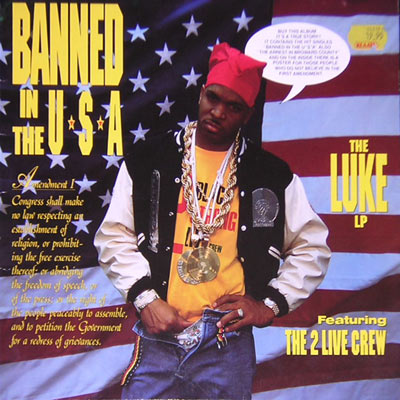 That again was me working for the record company, but it was an amazing experience. That was a promo piece, and they kind of represented it as a documentary. I tried to spin it as a doc, as opposed to a promo piece, but the record companies will do whatever they can to sell the new music. So I went down to Dallas, Texas and I filmed 2 Live Crew at this place called the Longhorn. I was with some girl from Atlantic Records who was like a little Beverly Hills princess. We were down there filming, and the club owner didn’t pay Luther Campbell, even though he was supposed to get paid up front. And so, Luther wouldn’t perform if he didn’t get his
That again was me working for the record company, but it was an amazing experience. That was a promo piece, and they kind of represented it as a documentary. I tried to spin it as a doc, as opposed to a promo piece, but the record companies will do whatever they can to sell the new music. So I went down to Dallas, Texas and I filmed 2 Live Crew at this place called the Longhorn. I was with some girl from Atlantic Records who was like a little Beverly Hills princess. We were down there filming, and the club owner didn’t pay Luther Campbell, even though he was supposed to get paid up front. And so, Luther wouldn’t perform if he didn’t get his  two G’s up front. So anyway, we got all the cameras going, and I’m shooting one camera, and I’ve got a guy on another camera. And Luther’s got a microphone backstage, and he won’t go out, because he hasn’t been paid, and the crowd outside’s getting really, really pissed off. He didn’t get paid, so we filmed him getting into his limo, driving off, and then we went back in — and the crowd destroyed every piece of furniture in that club, and we filmed it. And I remember crawling out on my hands and knees with a camera slung around my back, and going, “I just hope nothing falls on this camera.”
two G’s up front. So anyway, we got all the cameras going, and I’m shooting one camera, and I’ve got a guy on another camera. And Luther’s got a microphone backstage, and he won’t go out, because he hasn’t been paid, and the crowd outside’s getting really, really pissed off. He didn’t get paid, so we filmed him getting into his limo, driving off, and then we went back in — and the crowd destroyed every piece of furniture in that club, and we filmed it. And I remember crawling out on my hands and knees with a camera slung around my back, and going, “I just hope nothing falls on this camera.”
Also, there’s another one I did that I don’t think people really know about, and it was a film called The Lifers Group. We went to Rahway State Prison in New Jersey and filmed this group of rappers that were in there for life, because of murder mostly, 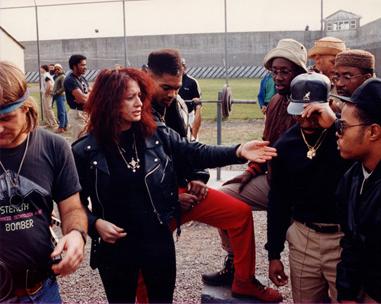 and it’s a pretty amazing piece. There’s all these shots of me standing in prison with all these guys, shooting. Again, it was Hollywood Records over at Disney, and this guy over there had heard of this group called The Lifers Group, and the music was actually pretty cool. It was different guys doing different rap songs, and so I filmed them all.
and it’s a pretty amazing piece. There’s all these shots of me standing in prison with all these guys, shooting. Again, it was Hollywood Records over at Disney, and this guy over there had heard of this group called The Lifers Group, and the music was actually pretty cool. It was different guys doing different rap songs, and so I filmed them all.
Some of the songs were personal, like “I can’t believe I’m in here forever.” Some of them were “I’m such a badass.” It was certainly a memorable experience to be on death row there in Rahway Prison. And in this Lifers Group, there was part of the Scared Straight program, where they take these guys out and let them talk to kids. I filmed some of the guys doing that Scared Straight program, because I remembered watching it. I think it’s great. It’s just another tough love thing where they’re like, “You wanna be like me? I’m gonna be executed for what I did.”

What do you recall of the rise in popularity of Rap music in ’80’s Los Angeles?
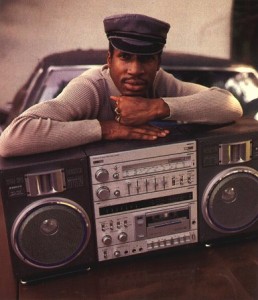 I remember being on Hollywood Boulevard one day — and I can’t remember if it was Public Enemy or NWA — one of those groups going down the Boulevard on a flatbed truck doing their rap songs with a big loudspeaker. That was kind of a trip. And I also remember being at a party one time, and some people said, “Let’s go down to this other party, because this new guy is down there.” It was right in the middle of the punk rock movement, and so rap was just being born. And they go, “It’s this guy named Grandmaster Flash.” So we went down there, and watched him do his spinning, and that was a pretty memorable night. But you know, because I was really more into punk, I spent my time there, and they were really kind of two different segments of the world. I remember though sitting at a table at Spago with Roger Corman and the producer of Suburbia. I said, “Roger, there’s this new music that’s just gonna take over the world, and it’s called rap.” He goes, “Rap? How do you spell it.” And I was offered at one point a million dollars to do a Decline movie called “The Rap Years,” but I didn’t do it because, first of all, nobody else is gonna own the Decline movies. And second of all, was that I didn’t feel I could do it well. You know, I didn’t go to rap shows and throw myself at the foot of the stage like I did at punk rock shows. It didn’t hit me as viscerally as punk did.
I remember being on Hollywood Boulevard one day — and I can’t remember if it was Public Enemy or NWA — one of those groups going down the Boulevard on a flatbed truck doing their rap songs with a big loudspeaker. That was kind of a trip. And I also remember being at a party one time, and some people said, “Let’s go down to this other party, because this new guy is down there.” It was right in the middle of the punk rock movement, and so rap was just being born. And they go, “It’s this guy named Grandmaster Flash.” So we went down there, and watched him do his spinning, and that was a pretty memorable night. But you know, because I was really more into punk, I spent my time there, and they were really kind of two different segments of the world. I remember though sitting at a table at Spago with Roger Corman and the producer of Suburbia. I said, “Roger, there’s this new music that’s just gonna take over the world, and it’s called rap.” He goes, “Rap? How do you spell it.” And I was offered at one point a million dollars to do a Decline movie called “The Rap Years,” but I didn’t do it because, first of all, nobody else is gonna own the Decline movies. And second of all, was that I didn’t feel I could do it well. You know, I didn’t go to rap shows and throw myself at the foot of the stage like I did at punk rock shows. It didn’t hit me as viscerally as punk did.
Speaking of Roger Corman, how did you sell him on the concept for Suburbia?
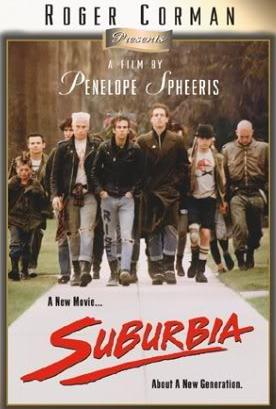 I had half the money, and Roger likes that. But I met this guy named Bert Dragin, and we’re still friends — and again, the only way I can explain this is that God was looking down on me and said, “You’ve gotta make this movie.” Bert had furniture stores in the Midwest, and he had just moved out here from Cleveland, and he wanted to make a movie. And I don’t know how I heard about him, but I remember the first time I went over to his house, and his wife was so nice. Her name was Ileene, and I remember she stood there and leaned sideways, and said, “Just remember this.” Anyway, Bert put in a quarter of a million dollars, and Roger Corman matched it. And I remember the day I walked away from Roger’s office over there on San Vicente, and I went, “Oh my God! I’m actually gonna make a movie here.” They own the rights to the movie, and everybody always wants to screen it, and so I always go back to them to get permission. I’m in touch almost weekly.
I had half the money, and Roger likes that. But I met this guy named Bert Dragin, and we’re still friends — and again, the only way I can explain this is that God was looking down on me and said, “You’ve gotta make this movie.” Bert had furniture stores in the Midwest, and he had just moved out here from Cleveland, and he wanted to make a movie. And I don’t know how I heard about him, but I remember the first time I went over to his house, and his wife was so nice. Her name was Ileene, and I remember she stood there and leaned sideways, and said, “Just remember this.” Anyway, Bert put in a quarter of a million dollars, and Roger Corman matched it. And I remember the day I walked away from Roger’s office over there on San Vicente, and I went, “Oh my God! I’m actually gonna make a movie here.” They own the rights to the movie, and everybody always wants to screen it, and so I always go back to them to get permission. I’m in touch almost weekly.
I am very fascinated by the idea that kids over the years have sort of imitated Suburbia. I made it up, that they went and lived in an abandoned house. It’s not that I knew any kids that were doing that. Yeah, I did know kids who were thrown out by their families, but nobody was squatting at that point that I knew of. It’s like the chicken and the egg here. Did Suburbia come first, and then they did it, or the other way around?
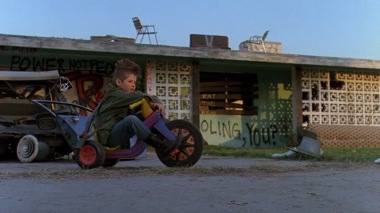 I’m a chronic news watcher. I always watch the news. I’ve watched every episode of 60 Minutes my whole life. I put together a bunch of these news stories, and I heard about this area in Downey — we used to call it “Downer” — where they’d forced everybody to move. They paid them very low dollars for their house, and took the rights, and boarded up all the houses, because they were gonna put a freeway in. And the legislation made it so that the freeway could not go in, so the houses just sat there for years. And the wild dogs that are in the movie were another story, where down in some other area of Orange County, which is where I’m from, there was a guard dog training school. They went out of business, so they just let the dogs loose, who were viscous.
I’m a chronic news watcher. I always watch the news. I’ve watched every episode of 60 Minutes my whole life. I put together a bunch of these news stories, and I heard about this area in Downey — we used to call it “Downer” — where they’d forced everybody to move. They paid them very low dollars for their house, and took the rights, and boarded up all the houses, because they were gonna put a freeway in. And the legislation made it so that the freeway could not go in, so the houses just sat there for years. And the wild dogs that are in the movie were another story, where down in some other area of Orange County, which is where I’m from, there was a guard dog training school. They went out of business, so they just let the dogs loose, who were viscous.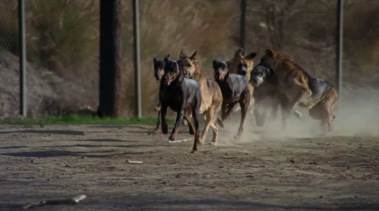
When we had casting sessions, I went to people I knew that were in bands, and would say, “Could you ask your friends if they’d like to come in and read?” I went mostly by just trying to cast by their look and the personality of the characters in the script. And for example, some of the stories, like the young girl that died and they took her back to her house, that actually happened to Darby Crash’s brother — and so his mother lost two kids to drugs. He died, and they brought him back and put him in his mother, Faith Baker’s car. So that’s where that came from, but I changed it to a girl because I didn’t wanna hurt the family. I just took stories that I had heard about, and then cast kids that I thought would fit the characters.
What aspects of the ’90’s LA punk scene did you set out to capture in The Decline Part III?
 I thought I was going to be making a movie about punk rock music again, because what inspired the first one was the music. A decent documentarian will let the subject matter carry her or him, and so the subject matter wasn’t the music at all. The subject matter turned out to be homeless youth, and gutter punks as we call ’em, crusty punks. They were indeed totally homeless, and there’s more of them now. They don’t have a connection with their families. Most of them have been treated really, really badly. I was just driving down Hollywood Boulevard the other day right near the freeway, and there they were — a guy and two girls, just dirty as hell, and you could tell that they’d been on the street just forever. And I remember back when I made The Decline III, there was this morning talk show host called Leeza Gibbons, and she saw the movie and wanted to do a story on it. So we brought the kids down to the studio, and of course they got drunk in the morning and wrecked the place, and they gave her lice.
I thought I was going to be making a movie about punk rock music again, because what inspired the first one was the music. A decent documentarian will let the subject matter carry her or him, and so the subject matter wasn’t the music at all. The subject matter turned out to be homeless youth, and gutter punks as we call ’em, crusty punks. They were indeed totally homeless, and there’s more of them now. They don’t have a connection with their families. Most of them have been treated really, really badly. I was just driving down Hollywood Boulevard the other day right near the freeway, and there they were — a guy and two girls, just dirty as hell, and you could tell that they’d been on the street just forever. And I remember back when I made The Decline III, there was this morning talk show host called Leeza Gibbons, and she saw the movie and wanted to do a story on it. So we brought the kids down to the studio, and of course they got drunk in the morning and wrecked the place, and they gave her lice.
 The Resistance were pretty much homeless. I said, “Well, where do you live?” And they said, “We do the couch tour.” We were in the home of Gizmo the drummer, and his mother makes that hoarding show look like a day at Disneyland. And you could see why he wouldn’t want to be there, although he’s a sweetheart and does take care of his parents. And those guys in Litmus Green, I think they had an apartment – one of the few bands that did. And then Naked Aggression, that was a boyfriend and girlfriend that had an apartment together, but all of their fans were virtually homeless.
The Resistance were pretty much homeless. I said, “Well, where do you live?” And they said, “We do the couch tour.” We were in the home of Gizmo the drummer, and his mother makes that hoarding show look like a day at Disneyland. And you could see why he wouldn’t want to be there, although he’s a sweetheart and does take care of his parents. And those guys in Litmus Green, I think they had an apartment – one of the few bands that did. And then Naked Aggression, that was a boyfriend and girlfriend that had an apartment together, but all of their fans were virtually homeless.
We’re talking desperate survival here. It’s not like they’re doing it because it’s cool. Well, maybe it starts out that way, but they’re in heavy duty survival mode. And they’ll go take a bath wherever they can, and get food wherever they can. You know, there’s a little section in the film where they call it 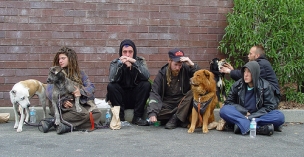 photo spanging, where they’ll charge people a dollar to take their picture. So yeah, the shelters do some of it, but I think a lot of the time they just live underneath the freeway. And then there’s places that start up, warehouses where a couple of them get some rent together and rent a warehouse in some shitty part of town. And all of them will live there, and then they’ll get kicked out. And there’s this place called the “drunk tank,” and they come and go from over there, but I mean it’s fucking filthy. It’s pretty bad, and with this economy it’s just gonna get worse.
photo spanging, where they’ll charge people a dollar to take their picture. So yeah, the shelters do some of it, but I think a lot of the time they just live underneath the freeway. And then there’s places that start up, warehouses where a couple of them get some rent together and rent a warehouse in some shitty part of town. And all of them will live there, and then they’ll get kicked out. And there’s this place called the “drunk tank,” and they come and go from over there, but I mean it’s fucking filthy. It’s pretty bad, and with this economy it’s just gonna get worse.
Tell me about your upcoming segment for Project Five.
 I was the last director to come on, and my section is about a stripper who has to get a double mastectomy, and her relationship with her husband who is a kind of young and gorgeous street thug. It’s about their relationship when this horrible thing happens to her, and it’s very emotional. The whole show is very emotional. I was given a script, and Marta Kauffman, who was a producer on Friends with Jennifer Aniston, she was the kind of writing supervisor. So, the subject matter really came from them and Lifetime. The biggest decision we had to make was were we actually gonna show the woman, played by Lyndsy Fonseca who’s on Nikita — were we actually gonna show that she had this mastectomy. And we did. And we not only made a prosthetic, but we also flew in a woman who is actually a sergeant I think in the Army, who did it as a precaution because she has that gene. So, we had a body double and a prosthetic.
I was the last director to come on, and my section is about a stripper who has to get a double mastectomy, and her relationship with her husband who is a kind of young and gorgeous street thug. It’s about their relationship when this horrible thing happens to her, and it’s very emotional. The whole show is very emotional. I was given a script, and Marta Kauffman, who was a producer on Friends with Jennifer Aniston, she was the kind of writing supervisor. So, the subject matter really came from them and Lifetime. The biggest decision we had to make was were we actually gonna show the woman, played by Lyndsy Fonseca who’s on Nikita — were we actually gonna show that she had this mastectomy. And we did. And we not only made a prosthetic, but we also flew in a woman who is actually a sergeant I think in the Army, who did it as a precaution because she has that gene. So, we had a body double and a prosthetic.